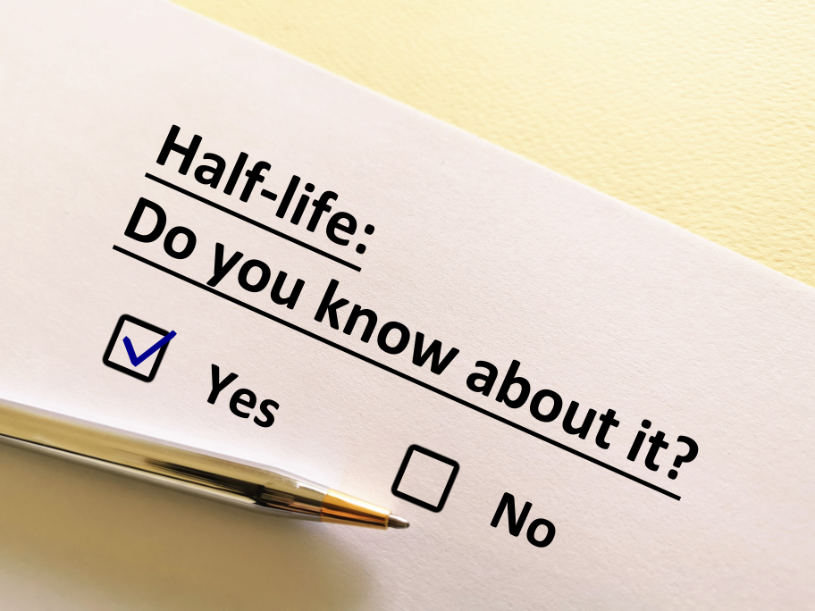Amitriptyline, a tricyclic antidepressant, has been extensively used in the treatment of a wide range of conditions, including depression, anxiety disorders, post-traumatic stress disorder (PTSD), insomnia, and premenstrual dysphoric disorder.
Despite this efficacy, the side effects, toxicity, and potential lethal overdose have led clinicians to prefer selective serotonin reuptake inhibitors (SSRIs) with a better safety profile. Yet, when these antidepressants fail, amitriptyline becomes a second-line treatment.
Most doctors recommend taking antidepressants for six months to a year. Going cold turkey with amitriptyline can be particularly harmful, often leading to withdrawal symptoms. Read on to learn about withdrawal amitriptyline and its management strategies.
Table Of Contents:
Amitriptyline Withdrawal Overview
Amitriptyline, under the brand name of Elavil, is a tricyclic antidepressant with a wide range of medical uses. Even though it’s FDA-approved to treat major depressive disorder (MDD) in adults, its off-label applications are extensive, including:
- Anxiety disorders
- Post-traumatic stress disorder (PTSD)
- Insomnia
- Somatoform disorders
- Chronic pain (diabetic neuropathy, fibromyalgia)
- Irritable bowel syndrome
- Interstitial cystitis (bladder pain syndrome)
- Migraine prophylaxis
- Neuralgia
- Sialorrhea (hypersalivation)
- Post-COVID headaches
Amitriptyline mechanism of action inhibits the reuptake of norepinephrine and serotonin, which increases their levels in the synaptic cleft of the brain, enhancing neurotransmission. This process helps relieve symptoms of depression and other disorders by stabilizing mood and easing pain.
When discontinuing amitriptyline, 56 out of 100 patients may experience withdrawal symptoms that could be severe if the cessation is abrupt. This withdrawal scenario occurs due to the body’s dependence on the drug’s presence to keep a neurochemical balance, leading to a set of withdrawal symptoms.
Amitriptyline Withdrawal Symptoms
Weaning off amitriptyline requires the brain and central nervous system (CNS) to adjust to functioning without the drug. You may find this phase under the name of antidepressant discontinuation syndrome (ADS), which is a group of symptoms that occur upon the abrupt cessation or decrease in dosage of antidepressants.
During ADS, neurotransmission can become unstable or erratic, leading to withdrawal symptoms. Some common side effects of amitriptyline may worsen during the discontinuation period. Research shows that 46% of individuals with withdrawal symptoms have undergone the most severe of them.
The severity of withdrawal symptoms depends on the dosage and the individual’s physiology. In case you are about to taper off amitriptyline, the mnemonic FINISH summarizes the symptoms of amitriptyline withdrawal you may experience:
- Flu-like symptoms (lethargy, fatigue, headache, achiness, sweating)
- Insomnia (with vivid dreams or nightmares)
- Nausea (sometimes vomiting)
- Imbalance (dizziness, vertigo, light-headedness)
- Sensory disturbances (“burning,” “tingling,” “electric-like” or “shock-like” sensations)
- Hyperarousal (anxiety, irritability, agitation, aggression, mania, jerkiness)
Other Elavil withdrawal symptoms may include:
- Appetite loss
- Diarrhea
- Depersonalization
- Muscle aches
- Aching joints
- Problems with concentration
- Memory problems
- Hallucinations (rare)

How Long Does Amitriptyline Withdrawal Last?
Symptoms are usually mild and can occur after discontinuing any type of antidepressant. They typically begin within two to four days after stopping amitriptyline and usually last one to two weeks, though in some cases, they may persist for up to a year.
Amitriptyline withdrawal timeline may vary among individuals, but you can expect progress according to the chart below:
| Period | Symptoms and Experiences |
|---|---|
| 1-3 Days | Initial withdrawal symptoms begin to appear. Mild headaches and nausea. Mild irritability and anxiety. |
| 4-7 Days | Symptoms peak during this period. The intensity of headaches and nausea increases. Noticeable irritability, anxiety, and agitation occur. Sleep disturbances and flu-like symptoms may occur. |
| 1-2 Weeks | For many individuals, symptoms are starting to subside. The intensity of headaches and nausea has decreased. There has been a gradual improvement in mood stability. However, there are ongoing sleep disturbances. |
| 3-4 Weeks | Significant reduction in most withdrawal symptoms. Residual irritability and anxiety. Improved sleep patterns. |
| 1-2 Months | Most physical symptoms have resolved. Possible lingering psychological symptoms (e.g., anxiety, mood swings). Continued improvement in overall well-being. |
| 3+ Months | Complete recovery for most individuals. Persistent symptoms are rare but may include mild psychological effects. Full return to normal CNS function. |
Duration and dosage of your amitriptyline use may be determining factors of how long you will experience withdrawal symptoms. If you have been taking the drug for over a year or at very high doses (commonly up to 150 mg, but possibly as high as 300 mg), it will take longer for symptoms to stop.
If you were on Elavil for less than four weeks and took the average 75 mg or less dose, you will likely feel better in two to three weeks. Also, withdrawal symptoms are closely linked to amitriptyline half-life, which is the time it takes for the concentration of the drug in the bloodstream to reduce by half.
How Long Does Amitriptyline Stay In Your System?
Antidepressant half-lives are crucial when considering the potential for withdrawal symptoms. Here’s why:
- Short half-life drugs leave the body more quickly, leading to more pronounced withdrawal symptoms.
- Longer half-life drugs are eliminated more gradually, resulting in milder withdrawal symptoms.
The half-life of amitriptyline is reported to be approximately 15 hours.
The drug’s concentration in the bloodstream takes about 15 hours to reduce by half.
It takes about 3.44 days for healthy adults to eliminate amitriptyline from the body, though not all metabolites are fully cleared from blood, saliva, urine, and hair. Healthcare providers and patients should consider the drug’s half-life to anticipate better and manage withdrawal symptoms.

What Helps with Amitriptyline Withdrawal?
Suppose you are prescribed amitriptyline and want to stop taking it due to side effects or improvement of your psychiatric condition. In that case, talking to your healthcare provider before making any sudden changes to your medication regimen is crucial. Antidepressant discontinuation symptoms can occur if you abruptly stop using amitriptyline or any other antidepressant.
To reduce your risk of experiencing withdrawal symptoms, your healthcare provider may recommend one of the following approaches:
- Gradually reducing the dosage under medical supervision.
- Work with your healthcare provider to create a tapering schedule personalized for you.
- Check in with your doctor to monitor your progress and adjust your tapering plan.
- A balanced diet supports overall health and can help mitigate physical withdrawal effects.
- Engaging in regular physical activity can reduce anxiety and help manage stress during withdrawal.
- Psychological support and therapy can be beneficial in managing emotional symptoms.
- Understand that withdrawal is a gradual process. Be patient with yourself as your body adjusts.
Tapering may not be necessary for patients who have been taking an antidepressant for less than four weeks or those taking fluoxetine.
If you are on a low dose of amitriptyline, tapering may be faster. However, it’s safe to remember that gradual tapering may not prevent withdrawal syndrome in all cases. If symptoms are severe, reintroduce amitriptyline and start slower weaning off amitriptyline.

Amitriptyline Withdrawal and Care − Key Takeaways
Though often uncomfortable, withdrawal symptoms are typically reversible, not life-threatening, and usually self-limiting. For some patients, switching to fluoxetine when discontinuing amitriptyline may be beneficial. To minimize withdrawal effects, it’s essential to approach the tapering process cautiously and under medical supervision.
While amitriptyline addiction is rare, the drug has the potential to cause dependence syndrome in vulnerable individuals, especially those with a history of substance abuse. If you are considering stopping amitriptyline, consult your healthcare provider to develop a safe and effective tapering plan for your health scenario.
People Also Ask
Can I stop taking Elavil cold turkey?
No, stopping Elavil abruptly can lead to withdrawal symptoms. Consult your healthcare provider for a gradual tapering plan for safe discontinuation.
How long does it take for amitriptyline to get out of your system?
In a healthy patient, amitriptyline is eliminated from the body in about 3.44 days, but metabolites may remain longer in blood, saliva, urine, and hair.
How to wean off amitriptyline and avoid withdrawal symptoms?
Gradually reduce the dosage under medical supervision, allowing your body to adjust slowly. Follow a personalized tapering schedule from your healthcare provider.
Hope Without Commitment
Find the best treatment options. Call our free and confidential helpline
Most private insurances accepted
Page Sources
- Amitriptyline for depression. (2024, April 17). https://www.nhs.uk/medicines/amitriptyline-for-depression/
- Thour, A., & Marwaha, R. (2023, July 18). Amitriptyline. StatPearls - NCBI Bookshelf. https://www.ncbi.nlm.nih.gov/books/NBK537225/
- Gonzalez-Martinez, A., et al. (2022). Amitriptyline for post-COVID headache: effectiveness, tolerability, and response predictors. Journal of Neurology, 269(11), 5702–5709. https://doi.org/10.1007/s00415-022-11225-5
- Davies, J., & Read, J. (2019). A systematic review into the incidence, severity and duration of antidepressant withdrawal effects: Are guidelines evidence-based? Addictive Behaviors, 97, 111–121. https://doi.org/10.1016/j.addbeh.2018.08.027
- Gabriel, M., & Sharma, V. (2017). Antidepressant discontinuation syndrome. CMAJ: Canadian Medical Association Journal, 189(21), E747. https://doi.org/10.1503/cmaj.160991
- PubChem. (n.d.). Amitriptyline. PubChem. https://pubchem.ncbi.nlm.nih.gov/compound/amitriptyline#section=Metabolism-Metabolites

 Authored by
Authored by  Reviewed by
Reviewed by 
